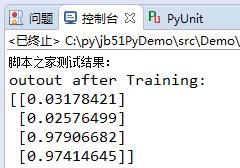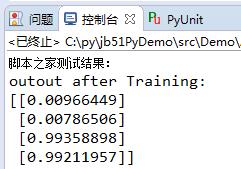本文實例講述了Python編程實現(xiàn)的簡單神經(jīng)網(wǎng)絡(luò)算法。分享給大家供大家參考,具體如下:
python實現(xiàn)二層神經(jīng)網(wǎng)絡(luò)
包括輸入層和輸出層
|
1
2
3
4
5
6
7
8
9
10
11
12
13
14
15
16
17
18
19
20
21
22
23
24
25
26
27
|
# -*- coding:utf-8 -*-#! python2import numpy as np#sigmoid functiondef nonlin(x, deriv = False): if(deriv == True): return x*(1-x) return 1/(1+np.exp(-x))#input datasetx = np.array([[0,0,1], [0,1,1], [1,0,1], [1,1,1]])#output datasety = np.array([[0,0,1,1]]).Tnp.random.seed(1)#init weight valuesyn0 = 2*np.random.random((3,1))-1print "服務(wù)器之家測試結(jié)果:"for iter in xrange(100000): l0 = x #the first layer,and the input layer l1 = nonlin(np.dot(l0,syn0)) #the second layer,and the output layer l1_error = y-l1 l1_delta = l1_error*nonlin(l1,True) syn0 += np.dot(l0.T, l1_delta)print "outout after Training:"print l1 |
這里,
l0:輸入層
l1:輸出層
syn0:初始權(quán)值
l1_error:誤差
l1_delta:誤差校正系數(shù)
func nonlin:sigmoid函數(shù)
這里迭代次數(shù)為100時,預(yù)測結(jié)果為

迭代次數(shù)為1000時,預(yù)測結(jié)果為:

迭代次數(shù)為10000,預(yù)測結(jié)果為:

迭代次數(shù)為100000,預(yù)測結(jié)果為:

可見迭代次數(shù)越多,預(yù)測結(jié)果越接近理想值,當(dāng)時耗時也越長。
python實現(xiàn)三層神經(jīng)網(wǎng)絡(luò)
包括輸入層、隱含層和輸出層
|
1
2
3
4
5
6
7
8
9
10
11
12
13
14
15
16
17
18
19
20
21
22
23
24
25
26
27
28
29
30
31
32
|
# -*- coding:utf-8 -*-#! python2import numpy as npdef nonlin(x, deriv = False): if(deriv == True): return x*(1-x) else: return 1/(1+np.exp(-x))#input datasetX = np.array([[0,0,1], [0,1,1], [1,0,1], [1,1,1]])#output datasety = np.array([[0,1,1,0]]).Tsyn0 = 2*np.random.random((3,4)) - 1 #the first-hidden layer weight valuesyn1 = 2*np.random.random((4,1)) - 1 #the hidden-output layer weight valueprint "服務(wù)器之家測試結(jié)果:"for j in range(60000): l0 = X #the first layer,and the input layer l1 = nonlin(np.dot(l0,syn0)) #the second layer,and the hidden layer l2 = nonlin(np.dot(l1,syn1)) #the third layer,and the output layer l2_error = y-l2 #the hidden-output layer error if(j%10000) == 0: print "Error:"+str(np.mean(l2_error)) l2_delta = l2_error*nonlin(l2,deriv = True) l1_error = l2_delta.dot(syn1.T) #the first-hidden layer error l1_delta = l1_error*nonlin(l1,deriv = True) syn1 += l1.T.dot(l2_delta) syn0 += l0.T.dot(l1_delta)print "outout after Training:"print l2 |
運行結(jié)果:

希望本文所述對大家Python程序設(shè)計有所幫助。
原文鏈接:http://blog.csdn.net/xiao_lxl/article/details/51721312










